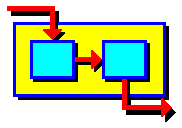Jerry Bieszczad
Ph.D. Thesis
The research concepts behind
MODEL.LA are described in Jerry Bieszczad's
Ph.D. thesis (Department of Chemical Engineering, Masssachusetts Institute
of Technology, February 2000). This thesis also describes the architecture
of the MODEL.LA Modeling Laboratory and provides several phenomena-based
modeling examples that illustrate its use.
The entire
thesis (in PDF form) may be downloaded here.
Alternatively, individual sections
may be downloaded from the following table of contents:
A Framework
for the Language and Logic of Computer-Aided Phenomena-Based Process Modeling
by
Jerry Bieszczad
©
2000 Massachusetts Institute
of Technology
All rights reserved.
- Title
Page
- Acknowledgements
- Table
of Contents
-
List of Figures
- List
of Tables
- Chapter
1 Introduction
- 1.1 Chemical Process
Modeling Needs in Engineering Practice
- 1.2 Chemical Process
Modeling Needs in Undergraduate Education
- 1.3 Potential Role
of the Computer in Process Modeling
- 1.4 Existing Computer-Aided
Process Modeling Tools
- 1.4.1 Sequential
Modular Flowsheet Simulators
- 1.4.2 Programming
Languages
- 1.4.3 Spreadsheets
- 1.4.4 Equation-Based
Process Modeling Tools
- 1.4.5 Summary of
Existing Computer-Aided Process Modeling Tools
- 1.5 Physicochemical
Phenomena-Based Process Modeling
- 1.5.1 Proposed
Phenomena-Based Modeling Approaches
- 1.5.2 Summary of
Proposed Phenomena-Based Modeling Approaches
- 1.6 Research Objectives
- 1.6.1 Development
of a Formalized Phenomena-Based Modeling Language
- 1.6.2 Systematization
of Modeling Activity through Modeling Logic
- 1.6.3 Implementation
and Evaluation of Modeling Language and Logic through a Computer-Aided
Modeling Environment
- 1.7 Thesis Outline
- Chapter
2 Requirements for High-Level Process Modeling
- 2.1 Requirements for
the Representation of Process Models
- 2.1.1 Declarative
Model Representation
- 2.1.2 Chemical
Engineering Science Basis of Models
- 2.1.3 Explicit
Documentation of Assumptions
- 2.1.4 Hierarchical
Nature of Models
- 2.1.5 Contextual
Nature of Models
- 2.2 Requirements for
Systematization of the Process Modeling Activity
- 2.2.1 Procedural
Nature of Modeling Activity
- 2.2.2 Contextual
Nature of Modeling Activity
- 2.2.3 Science and
Art of Modeling
- 2.2.4 Documentation
of Modeling Activity
- 2.3 Implementation
of High-Level Computer-Aided Modeling Support
- 2.3.1 Phenomena-Based
Modeling Language
- 2.3.2 Modeling
Logic
- 2.3.3 Computer-Aided
Modeling Environment
- Chapter
3 Modeling Language Framework
- 3.1 Formal Modeling
Language Representation
- 3.2 Hierarchy of Model
Equations
- 3.3 Phenomena-Based
Model Characterization
- 3.3.1 Structural
Characterization
- 3.3.2 Chemical
Characterization
- 3.3.3 Derivation
Context
- 3.4 Characterization
of Modeling Elements
- 3.4.1 Modeled-Unit
Characterization
- 3.4.2 Flux Characterization
- 3.4.3 Material-Content
Characterization
- 3.4.4 Phase Characterization
- 3.4.5 Chemical
Species Characterization
- 3.4.6 Chemical Reaction
Characterization
- 3.5 Semantic Relationships
- 3.6 Model Digraph
- 3.7 Model Derivation
Tree
- 3.8 Complete Context-Free
Grammar Description
- Chapter
4 Modeling Logic Framework
- 4.1 Computational Logic
- 4.2 Formal Description
of Modeling Logic Operators
- 4.2.1 Modeling
Logic Operators
- 4.2.2 Elementary
Graph Operators
- 4.3 Model Analysis
Operators
- 4.3.1 Modeling
Element Identification
- 4.3.2 Hierarchical
Structure
- 4.3.3 Topological
Structure
- 4.3.4 Material
Characterization
- 4.3.5 Chemical Content
- 4.3.6 Mechanistic
Characterization
- 4.4 Model Construction
Operators
- 4.4.1 Modeling
Elements
- 4.4.2 Topological
Characterization
- 4.4.3 Chemical
Content
- 4.4.4 Hierarchical
Characterization
- 4.4.5 Material
Characterization
- 4.4.6 Mechanistic
Characterization
- 4.4.7 Behavioral
Characterization
- 4.5 Model Consistency
Operators
- 4.5.1 Hierarchical
Consistency
- 4.5.2 Material
Characterization Consistency
- 4.5.3 Species Topology
Rules
- 4.6 Model Completeness
Operators
- 4.7 Model Derivation
Operators
- 4.7.1 Chemical
Species Conservation Equation Derivation
- 4.7.2 Energy Conservation
Equation Derivation
- 4.7.3 Chemical
Reaction Rate Equation Derivation
- 4.7.4 Material-Content
Characterization Equation Derivation
- 4.7.5 Phase Characterization
Equation Derivation
- 4.7.6 Mechanistic
Characterization Equation Derivation
- 4.7.7 Thermodynamic
and Physical Properties of Phases Equation Derivation
- 4.7.8 Thermodynamic
and Physical Properties of Fluxes Equation Derivation
- 4.8 Model Explanation
- 4.9 Extensions to Modeling
Logic Operators
- 4.10 Supervisory Logic
Operators
- Chapter
5 The MODEL.LA Modeling Environment
- 5.1 Software Structure
- 5.2 Model Generator
- 5.2.1 Topological
Structure
- 5.2.2 Hierarchical
Structure
- 5.2.3 Chemical
Characterization
- 5.2.4 Phenomena-Based
Mechanistic Characterization
- 5.2.5 Phenomena-Based
Model Summary
- 5.2.6 Mathematical
Model Derivation
- 5.3 Properties Manager
- 5.3.1 Pure Species
Properties
- 5.3.2 Binary Interaction
Parameters
- 5.3.3 Material
Behavior Analysis
- 5.4 Operations Manager
- 5.4.1 User Equations
- 5.4.2 Process Controllers
- 5.4.3 External
Models
- 5.4.4 Operational
Schedules
- 5.5 Numerical Engine
- 5.5.1 Display of
Model Equations
- 5.5.2 Design Variable
Specification
- 5.5.3 Index Analysis
- 5.5.4 Initial Conditions
- 5.5.5 Initial Guess
Specification
- 5.5.6 Solution
of Model Equations
- 5.5.7 DAE Systems
Numerical Solution Methods
- 5.5.8 IPDAE Systems
Numerical Solution Methods
- 5.5.9 Display of
Numerical Results
- 5.6 Summary of MODEL.LA
Modeling Environment
- Chapter
6 Software Design of the MODEL.LA Modeling Environment
- 6.1 The Object Modeling
Technique
- 6.2 MODEL.LA Modeling
Element Object Models
- 6.3 MODEL.LA Modeling
Environment Object Models
- 6.4 Functional Model
of the MODEL.LA Modeling Environment
- 6.5 Summary of MODEL.LA
Modeling Environment Software Design
- Chapter
7 Phenomena-Based Modeling Examples
- 7.1 HDA Plant
- 7.2 Acetic Anhydride
Plant
- 7.3 Dynamic Distillation
Column Example
- 7.4 1-D Spatially Distributed
Reaction and Separation Processes
- 7.5 2-D Tubular Reactor
- 7.6 Summary of Model
Examples
- Chapter
8 Conclusions and Recommendations
- 8.1 Research Contributions
- 8.1.1 Phenomena-Based
Modeling Language
- 8.1.2 Formalized
Modeling Logic
- 8.1.3 Computer-Aided
Modeling Environment
- 8.2 Potential Impact
on Modeling in Engineering Practice
- 8.3 Potential Impact
on Undergraduate Chemical Engineering Education
- 8.3.1 Structuring
of Modeling Activities
- 8.3.2 Classroom
Deployment of MODEL.LA
- 8.3.3 Pedagogical
Use of MODEL.LA
- 8.3.4 Unique Impact
on Undergraduate Education
- 8.4 Directions for
Future Research
- 8.4.1 Phenomena-Based
Modeling Language Extensions
- 8.4.2 Integration
with Molecular Modeling Tools
- 8.4.3 Implementation
of Supervisory Logic
- 8.4.4 Standardization
and Integration with External Modeling Tools
- 8.5 Conclusions
- Bibliography
- Appendix
A MODEL.LA Context-Free Grammar
- Appendix
B Properties Manager
- Appendix
C Operational Schedules
- Appendix
D Jacketed-CSTR Model Equations
- Appendix
E 2-D Spatially Distributed Tubular Reactor Model Equations
|

